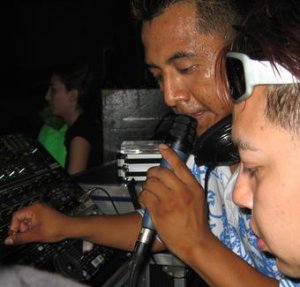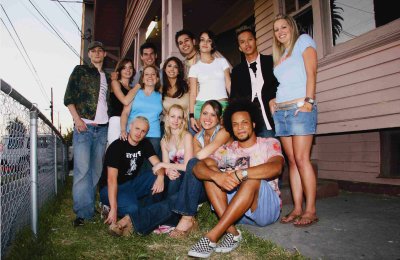Posted by Elena del Valle on October 12, 2009

Three Olives Vodka Grape print ad
Video: 5W Public Relations
Earlier this year, Proximo, a spirits importer, launched a new, multi-million dollar television comic advertising campaign for Three Olives Vodka, the brand’s first broadcast outreach. Parallel efforts in print and an online contest will support the What’s Your O-Face? Campaign and its 10 new 30-second television spots. The idea behind the campaign is to emphasize that drinking their vodka is fun and promote the flavors of the company’s vodka line. Scroll down to watch Three Olives Vodka ads.
“The development of our new campaign was driven by research that produced two key findings: first, that consumers felt the fun had been taken out of vodka with virtually all brands scrambling for the same crowded, so-called ‘luxury’ positioning,” said Elwyn Gladstone, vice president of Marketing at Proximo.
“Secondly, the Three-O flavor range has become the benchmark amongst flavored vodkas for its wild, surprising and intense taste experience. These findings are reflected in the hilarious imagery of the new campaign, featuring a series of situations that one would expect to garner a look of shock, but instead are met with a stoic impression. That is, until the subject tastes shockingly delicious Three-O Vodka.”

Three Olives Vodka Root Beer print ad
The $10 million television campaign, created by Agent16, formerly Mezzina Brown & Partners, a New York-based advertising agency, was launched August 31 on cable channels BRAVO and E! Plans were in the works for buys of interactive, expandable rich media on TMZ and Perez Hilton to showcase the complete collection of TV spots, as well as continuing the print campaign in national magazines, including Maxim and US Weekly.
Imported from England Three Olives Vodka is handcrafted in small batches and made from English wheat after quadruple distilling and quadruple filtration. It’s available in 17 flavors including Cherry, Grape, Passion Fruit, Pomegranate, Chocolate, Mango, Root Beer, Tomato, and Triple Shot Espresso, and Bubble, the newest flavor. It sells for $19.99 and up for a 750 milliliter bottle.
Proximo, a family owned company based in New York City, also sells 1800 Tequila, Gran Centenario Tequila, Maestro Dobel Diamond Reposado Tequila, and Ron Matusalem rum.
Posted by Elena del Valle on January 11, 2007
A young DJ delivers a home-grown tradition to New York Mexicans, one of the city’s hardest-pressed immigrant groups
By Miguel Angel Angeles

Sonido Kumbala is a revered figure on New York’s sonidero scene
Photo: Elizabeth Campos
You can barely hear the lyrics of Julieta Venegas’ recent hit “Me Voy,” since a deep voice shouting over her number booms from the speakers. Some people stand and watch, as colored lights fall on disco balls spinning over the crowd on the dance floor. But others make their way to the man behind the voice: Alejandro Aviles, aka Sonido Kumbala, a Mexican DJ in New York who has developed a following and a measure of fame.
“He plays our music,” said Ramíro Salazar, 18, of the Bronx. “This is a place where we can hang out and dance and forget about everything out there for a while.”
Now celebrating his 10th anniversary of performing for crowds of Mexican and Mexican-American youth, Sonido Kumbala, 28, is an important figure in New York City’s sonidero scene, an essential part of Mexican youth culture. The practice, which migrated from Mexico City, centers around the sonidero, a type of DJ who, rather than mixing songs on a turntable, sends shoutouts over Colombian cumbia.
A young man might proclaim his love to his girlfriend, shout-out to his friends, or send a greeting to his family. They could be in the same dance hall, in New Jersey, or in the Mexican state of Puebla. The performance will be recorded, and CDs of the event will be sold as early as the next day. The dedicator of a number can then buy the CD and send it to the girlfriend left behind in Mexico, give it to friends, or keep it as a memento.
The sonidero’s voice is key to his success, said Aviles, who is single and lives with a friend in Queens. Aviles’ voice is deep, raspy, strong, and emphatic. It’s a voice that took him years to master.
“My voice was horrible when I began — so immature,” he said, laughing. “Sometimes the fact that people liked me then is more shocking than the fact that I’ve become successful.”
“The sonidero music scene is … a place [for Mexicans] to see and be seen with status, a rarified space for asserting their dominance and power,” said Robert C. Smith, an associate professor of public affairs at Baruch College.
Mexican immigrants are among New York’s poorest, relatively recently arrived and working at some of the most strenuous jobs for the lowest pay, as little as $2 an hour, according to New York’s Tepeyac Association, a Mexican rights and assistance group. Since Mexican social spaces are still in the process of being created, young people lack a space for self expression, Smith said. The sonidero scene is a ready, though ephemeral, way for them to interact.
Aviles, who remembers attending open-air sonidero events, along with thousands of other adolescent and adult fans in Mexico City, said it felt good to be able to remind people of home.
“Many people, when they come to this country, want to follow in their traditions,” he said. “I want to give them something, if even for a short while, that even though they are so far from Mexico, they can feel it is near.”
Aviles, who is from Morelos state, was 12 when he went to Mexico City with his father, to help him deliver tortillas. He grew familiar with music stands selling sonidero and dance club music. As a teenager, he preferred club music. But when he arrived in New York in 1992 at the age of 15, he found sonidero music wildly popular among Mexicans there.
He met Fausto Salazar, a leading artist with the stage name Sonidero Potencia Latina, who made Aviles his apprentice. At 18, Aviles struck up a partnership with another friend, and began playing at private events. He lived through some rocky days. After he bought out the friend and their equipment for $8,000, he weathered a string of canceled gigs, equipment malfunctions, and sleepless nights, going straight from factory jobs to sonidero events, and often right back to work. He considered giving up the sonidero life. But his mother urged him on, reminding him that, if he wanted to be successful, he’d have to persevere.
One day, he was over the hump.
“In the blink of an eye, I began to get work,” recalled. He paid off his debts, and his career took off.
“I like Kumbala, because he’s always updating his music,” said Elizabeth Campos, 23, of Queens, a fan since 1997. “He doesn’t only play cumbias, but also reggaeton, duranguense, rancheras, bachata, rock, pop, English, Spanish.” Fans also thank him for giving young Mexicans and Mexican-Americans a way to engage with one another and to express themselves.
“Kumbala, he looks out for us,” said Alvaro Beltran, 21. “In July he held his tenth anniversary sonidero dance for free. Totally free! No one has ever done that before.”
Miguel Angel Angeles is a graduate student at New York University’s Center for Latin American and Caribbean Studies. A native of California, his interests include Chicano studies, popular culture and Mexican life in New York.
Comments:
Filed Under:
Posted by Elena del Valle on September 26, 2005

Second Season: “Urban Jungle 2: South Central”
Critically-Acclaimed Reality Show Transplants 13 Privileged Suburbanites into “The Hood” to Experience Life as Immigrants
Los Angeles, CA (Sept. 19, 2005) – Sí TV, the first English-language Latino cable network, announced the return of its hit reality series “Urban Jungle,” the show that takes 13 sheltered kids from suburbia and plops them in South Central Los Angeles, all for a chance to win a $50,000 grand prize. The second season, “Urban Jungle 2: South Central,” premieres on Sunday, October 9, 2005 at 10 PM (ET/PT) on Sí TV and will air every Sunday at 10 PM for 13 weeks.
“Our first season of ‘Urban Jungle’ was wildly successful. Sí TV is proud to bring back a second season,” says Sí TV co-founder and chairman Jeff Valdez, who grew up in the housing projects of Pueblo, Colorado. “With so much anti-immigrant sentiment these days, we want to give our contestants and our viewers a chance to find out what it’s really like to live as working class poor and in the process uncover the humanity of the working-class immigrant.”

Jeff Valdez, Sí TV co-founder and chairman
Returning producer Roni Menendez and camera crews converge on the tiny two-bedroom, one-bath home in South Central Los Angeles to follow the group of 13 privileged twenty-somethings as they adapt to life as immigrants. This season Urban Jungle raises the stakes by adding a new element, paying the rent.
Last year, contestants were given jobs to test their resolve. This year, it’s all about the cold, hard cash. In addition to seeking out their own jobs, each week, contestants will be issued a “Challenge.” Challenges including picking strawberries, selling paletas (popsicles) and selling oranges on freeway off ramps. The losing team will have to pay the rent for the house. Members from the losing team who can’t contribute must plead their case for staying in the house to Pete Esquivel (Little Heroes), Monique Marvez (Rocking New Year’s Eve) and Thea Vidale (Thea), the three street-wise, yet benevolent “Padrinos” (Godparents).
Based on each contestant’s sincerity, the Padrinos will decide who to “evict.” The added stress of paying the rent, and the third-world living conditions will create intense pressure and lead to dramatic clashes. The last contestant in the house, producers say, will win $50,000 in cash and prizes, and perhaps learn a thing or two about life on the other side of the tracks.
New participants include:
· Georgie, 29, Winnetka, California, the daughter of a wealthy South African family who enrages her housemates with her brutally honest comments.
· Jei, 23, Los Angeles, California, a Buddhist ex-Marine who doesn’t mince words when it comes to politics.
· Michael, 28, San Antonio, Texas, a self-proclaimed metrosexual and ultra clean freak, who creates havoc in the house with his primadonna antics.
· Jason, 23, San Pedro, California, a highly opinionated surfer and musician who has no patience for “stupid, fake” people.
· Leann, 23, Springdale, Arizona, a typical wide-eyed small-town girl from Arkansas who has never been exposed to city life.
· Bo, 24, San Antonio, Texas, a titillating Texas princess with impeccable good looks who works as a local TV personality.
· Aubrey, 22, Woodside, New York, a social butterfly who has lived a life of privilege and spends summers at her family’s Italian villa.
· Mark, 21, San Rafael, California, a quintessential jock with a nose for politics who admit to having a low tolerance for stupidity and can be a bit abrasive.
· Kristi, 24, Burbank, California, a tough-talking straight-shooting party girl who is used to running with the popular crowd.
· Tristan, Los Angeles, California, 26, an eccentric playboy clothing designer who lives on Los Angeles’ west side.
· Erik, 23, New Rochelle, New York, a comedian of Puerto Rican heritage who lives in ritzy Westchester County, NY and is supported by his daddy who works in pediatrics.
· Afradet, Austin, 22, Texas, a sassy recent graduate of Palestinian background who is not afraid of a little disagreement.
· Vanessa, 23, San Diego, California, a controversial contestant from Urban Jungle season one returning for a second chance at the prize.
Sí TV is an English-language, Latino network featuring hip and irreverent, culturally-relevant programming targeting the growing young Latino and multi-cultural TV audience. Voted by Multichannel News as one of the “Top 10 Next Networks,” Si TV reaches 10 million homes nationwide. The network has forged affiliation agreements with Comcast Cable, Adelphia, Time Warner Cable, Cox Communications and Grande Communications, while EchoStar’s DISH Network features Sí TV as part of its “America’s Top 120” package. Investors in the network include EchoStar Communications Corporation (NASDAQ: DISH), Time Warner Inc. (NYSE: TWX), SYNCOM Funds, Columbia Capital, Rho Ventures, DND Capital Partners, Llano Partners and company co-founder Barshop Ventures.
Co-founded and chaired by Jeff Valdez, who was recently named a “Top 10 Player” in Hispanic media by Ad Age Magazine, Sí TV was established in 1997 as a production company to develop, produce and distribute original English-language, Latino-themed entertainment.
Comments:
Filed Under: Media















